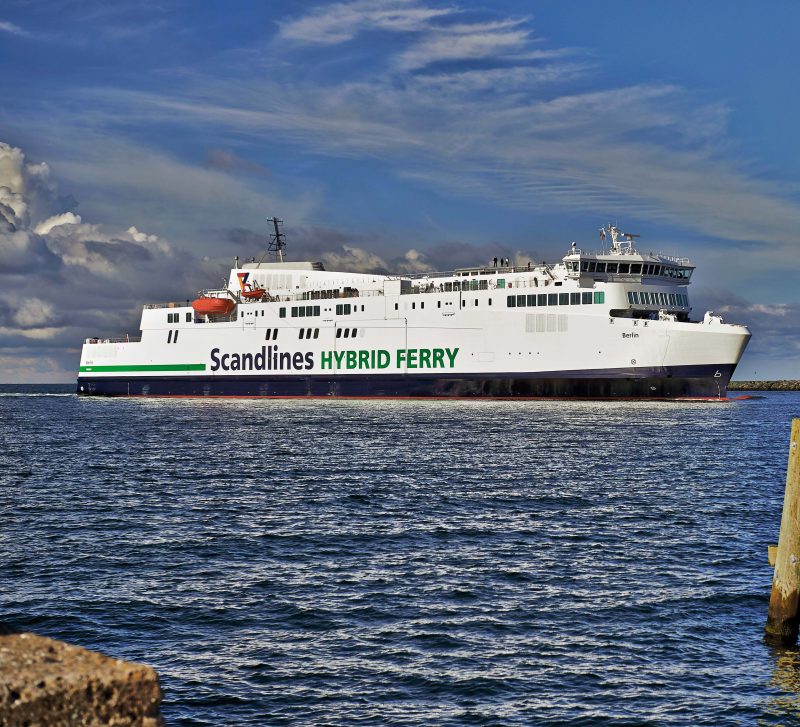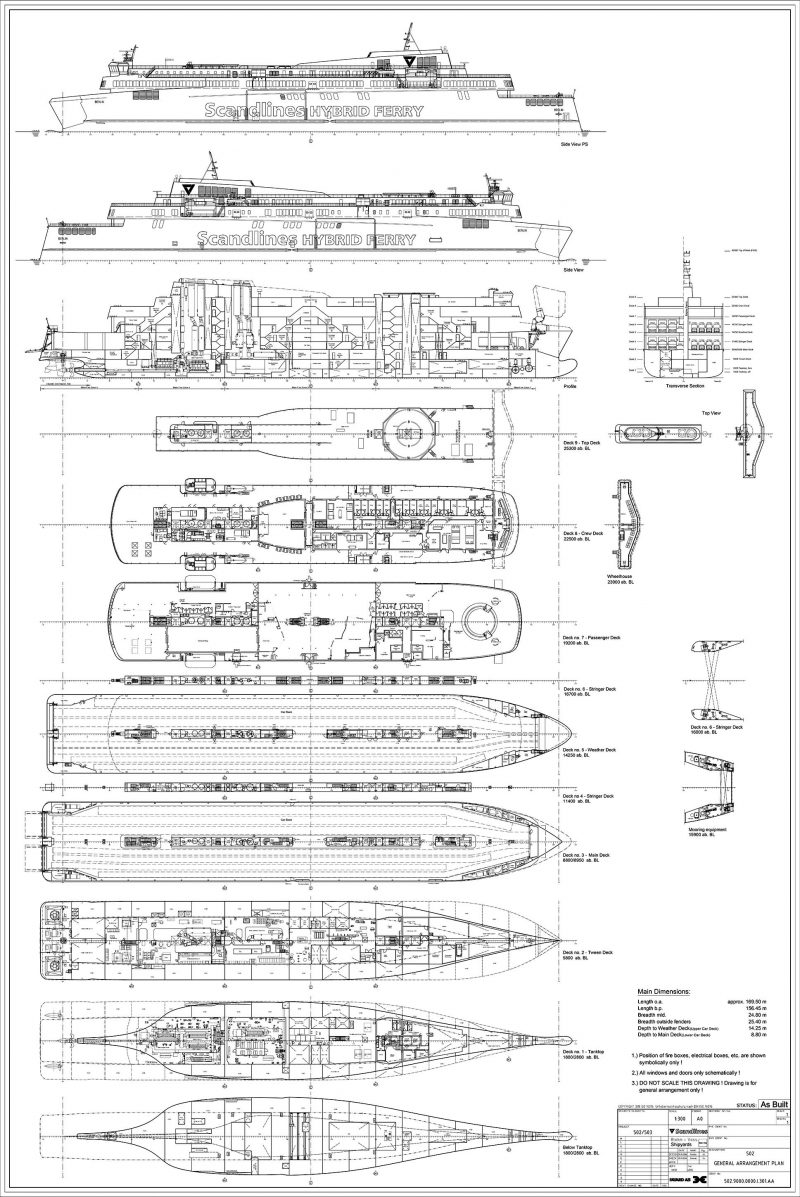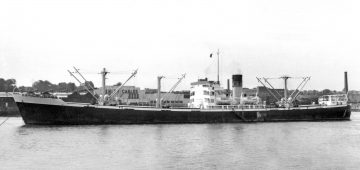It was back on 26th March 2010 that Scandlines announced that a contract had been signed with P+S Werften of Stralsund, Germany for the construction of two new passenger and vehicle ferries for the company’s Gedser–Rostock route. The new vessels represented a total investment of €230 (including shore works) and would double capacity on the two-ship service when introduced in 2012.
The shipyard in Stralsund, a Hanseatic town in Mecklenburg-Vorpommern, Germany, with access to the Baltic Sea, was founded as Ingenieurbau G.m.B.H. in 1945. The facility became VEB Volkswerft Stralsund as from 1948. From 1948 to 1953 the shipyard produced 196 ships, all of them to be used for reparation payments to the Soviet Union. In October 1957, the first ship built for a fleet not pertaining to the Eastern Bloc was delivered to Iceland. In 1973, Lloyd’s of London saw the Volkswerft as number one in the production of trawlers worldwide. After 1990, the Volkswerft was privatised twice, first as Volkswerft Stralsund GmbH becoming part of the Vulkan-Gruppe (Bremen) in 1993, then, in 1998, as part of the Maersk-group, Maersk having paid 25m Deutschmarks. The yard has a large shipbuilding hall and a 275m ship lift to launch the ships. Maersk built 3,000 TEU capacity containerships here with a multitude of other vessel types being constructed. In 2010 Volkswerft Stralsund and the Wolgast shipyard (founded in 1948) on the River Peene in Mecklenburg were merged to become P+S Werften. Owned jointly by the Hegemann Group and a subsidiary Frankfurt Cornelius Treuhand GmbH, the yards had previously received loans of €48 million between them from the state of Mecklenburg- Vorpommern. Shortly after the inception of P+S Weften came the Scandlines order for their new ferries and the keels were laid for Newbuild Nos.502/503 on 28th June 2010. On 2nd December 2011, the first ship, to be named Berlin, was lowered into the water having emerged out onto the shiplift from the building hall the previous evening beneath a plethora of fireworks. Around 150 guests attended the event.
On 9th February 2012 the Berlin was christened at the shipyard. Scandlines AG was founded in 1998 with headquarters in Rostock, has two divisions (Scandlines Deutschland GmBH and a Danish subsidiary Scandlines Denmark ApS) and operates three services between Puttgarden-Rødby, Helsingør-Helsingborg and Rostock-Gedser. Owned 100% by the 3i Group since 2010, Scandlines was originally co-owned by the Danish Ministry of Transportation (50%) and Deutsche Bahn AG (50%) until 2007 when sold to a consortium consisting of 3i Group of London (40%), Allianz Capital Partners (ACP) of Munich (40%) and Deutsche Seereederei (DSR) of Rostock (20%).
In June 2012 Stena Line and Scandlines announced that Stena would purchase Scandlines’ Sweden and Baltic services. With more than 90,000 departures on 12 ferries, in 2015 Scandlines transported 15 million passengers, 3.3 million cars, 900,000 freight units and 65,000 coaches.
The crossing time of the Rostock- Gedser route that the new ferries were built for is approximately two hours. Rostock is the largest city in the north German state of Mecklenburg- Vorpommern and is located on the Warnow River slightly inland from the Baltic Sea. Gedser is the southernmost town in Denmark at the southern tip of the island of Falster in the Guldborgsund Municipality in the Sjælland region.
Troubled Waters
Delivery was scheduled for February 2012 but this timetable began to slide when issues were discovered with the newbuild. Construction of the sistership Copenhagen commenced on 28th June 2010 and she was launched 4th April 2012, considerably behind time. It became apparent that seemingly inaccurate computer calculations and materials used in the construction of the ships had caused the deadweight to be exceeded by 200 tonnes. The ship’s draught was subsequently 22cm more than the design so the vessels would not have been able to enter port on certain low tides and dredging work was prohibitive on cost grounds. The increased deadweight caused a potential reduction in vehicle capacity (equivalent to 150 cars), which would of course have impacted upon the revenue earning capability for both ships. As of March 2013 P+S Werften entered an economic downturn owing to a €200 million shortfall. In July 2012, the EU Commission approved a state guarantee in the form of a loan of €152.4 million for the P+S shipyards, so that further production was secured for the time being. The federal government and the state of Mecklenburg-Western Pomerania each vouched for this, 50% a piece, plus the employees agreed to participate in the rescue with €68 million. The situation escalated quickly and on 20th August 2012, it became known that the shipyards in Stralsund and Wolgast would not receive any further loans guaranteed by the federal government and the state. Since the existing credit agreement was insufficient to complete existing contracts, P+S Werften filed an insolvency petition with the Stralsund courts on 29th August 2012. The following month DFDS Seaways cancelled a €124m contract for two special Ro-Ro ships that were in build due to delivery delays. (These were later delivered to DFDS at a renegotiated price as the Ark Germania & Ark Dania – Newbuild Nos. 500/501 – see a previous Newbuild of the Month).
As the insolvency process rumbled on, with its associated recriminations, Scandlines announced on 28th November 2012 that it had decided to cancel the contracts with P+S Werften GmbH concerning the construction of the new vessels, which had been due for delivery from February 2012. Despite Scandlines’ strong commitment it had not been possible to find a solution to the severe technical problems that had occurred during the building process, thus delaying the delivery. The cancellation was made on the basis of the yard’s failure to construct the vessels in line with the contractual specifications. Three attempts had been made to reduce the deadweight issue on the two ships but all failed to address the situation. The existing ferries at the time, the 16,071ft/1980 built Prins Joachim and the 16,071ft/1981 built Kronprins Frederik, continued as the route’s backbone and both received an internal refresh to extend their working lives with Scandlines. The shipyard’s financial issues were reportedly already present before the €152m in state rescue aid had been received. In December 2012 the Wolgaster Peene shipyard was sold to the Bremen based Lürssen Shipyard group for almost €20m, with effect from 1st May 2013, whilst Nordic Yards bought the shipyard in Stralsund on 1st June 2014. On 2nd March 2016 Genting Hong Kong announced the acquisition of Nordic Yards’ three shipyards in Wismar, Warnemunde and Stralsund, Germany for €230.6m. It had been quite an eventful six years for the yard.

Full Circle
The abandoned ships remained at P+S Werften and Scandlines went back to the drawing board regarding tonnage for the Rostock-Gedser operation. On 3rd July 2013 the company announced the signing of a Letter of Intent with STX Finland for the building of two new ferries for delivery in spring 2015. The project was to bring some 1,000 man-years of work for STX Finland and its subcontracting network. Incredibly, lightning did strike twice as the process was stalled by monetary issues involving yard owners STX, (the Finnish yard is now the thriving Meyer Turku outfit), and the Finnish government not backing the financial requirements. The contract was abandoned and Scandlines then did a dramatic U-turn and announced the purchase of the sisterships Berlin and Copenhagen from their Builder’s insolvency administrator Berthold Brinkmann on 31st January 2014 for €31.6 instead of the original €184m. The company was criticised for this move but the ships were not to specification and required much work to make them suitable for the desired purpose. The rebuild of the ships would cost in excess of €100m so costs would eventually be similar to the original contract. Both ferries also lacked any interiors so were incomplete shells.
On 30th April 2014 Scandlines signed a Letter of Intent (LOI) with Blohm+Voss (B+V) for the completion of the two ferries. The Berlin and Copenhagen were towed in turn from Stralsund via the Kiel Canal to B+V in Hamburg, Newbuild No.502 arriving first on 20th May 2014. The ships were extensively surveyed regarding the necessary rebuild to correct the deadweight issues and on 11th July 2014 a further contract was signed with FAYARD A/S in Munkebo, Denmark for the rebuilding of the duo. FAYARD (Fredericia Shipyard) moved to its present spacious location in 2010 from Fredericia and was founded by the Andersen family in 1916. There are four dry docks and the site handles refits, rebuilds, conversions, retrofits and repairs. Munkebo is a town in central Denmark near Odense, located in Kerteminde municipality, a region of Southern Denmark on the island of Funen.
The two ferries were then towed one by one from Hamburg to Munkebo with the Berlin arriving on 18th July 2014. The Copenhagen quickly joined her after passing through the Kiel Canal for a second time on 22nd July 2014. On 3rd December 2014 Scandlines announced that the rebuild was progressing well with a service debut hoped for in the second half of 2015 but completion of the project was postponed several times.
The weight of each new ferry was reduced by around 1,100t to address the 200t excess deadweight and 22cm excess draught issues. This involved removing the upper passenger areas (decks 8 & 9) and replacing these with a narrower Deck 8. Deck 7 was reduced by 10m and, along with Deck 8, received new furniture fabri cated from lightweight material. The bridge and the crew areas have been replaced by aluminium structures. These alterations reduced the passenger capacity by 200 to a maximum of 1300. The vehicle decks remained unchanged, with capacity for 46 trucks and 230 cars or a maximum of 96 trucks – representing a total weight of 1,600t. The main vehicle deck (Deck 3) and upper vehicle deck (Deck 5) can each accommodate 48 trucks, 230 cars or 800 lanemetres of mixed traffic. The total lanemetre capacity is 1,600lm. The deck load of Deck 3 is 2.00t/m2 and 15t/axle whilst the deck load of Deck 5 is 1.50t/m2 and 15t/axle (figures based on 3 axles, axle distance 1.30 m). Access to Decks 3 & 5 offers a clear height of 4.60m and 4.20m respectively and a maximum vehicle width of 5.00m. The overall width of access over the bow is 10m and the stern access is via two 6m long ramps. Vehicle lanes are 1750mm wide for cars and 2550mm wide for trucks. The vehicle access inclination over the bow and stern is +/- 6 degrees and each ship can achieve a port turnaround in 15 minutes. The sisterships are 169.50m long overall with a moulded beam of 24.80m. The draught after rebuild is 5.50m and the hull depth to the weather deck is 14.25m. The deadweight at 5.50m draught is 3,434dwt and the gross tonnage is 22,319gt. The new look passenger accommodation on decks 7 and 8 offers several catering areas with general seating and lounges. The forward part of deck 7 is the Scandlines Buffet Restaurant (308 seats) and midships is the 304 seat FoodXpress Café. Two lounges on the port side offer 222 and 71 seats respectively. Aft is a 400 m² shopping area. Also on Deck 7 is the Good to Go convenience outlet and a children’s play area. Deck 8 aft offers the Scandlines Lounge, the Xpresso Café and an open sun deck. In the forward area of this deck can be found the crew and officer cabins, crew mess, crew day room, offices, air conditioning rooms etc.
During the rebuild the machinery was also renewed in favour of a hybrid system rather than five MaK diesel units. The main diesel engines are two 4,500kW Caterpillar units which operate at optimum efficiency. Also installed is a 4,500kW auxiliary generator set, a harbour generator set plus a 4,500kW unit to charge the 1,500kWh battery storage system supplied by Canadian manufacturer Corvus Energy. During each crossing the batteries are charged and the power is then available for port manoeuvres. The 4,500kW hybrid engine can either operate whilst geared directly to the centre propeller or act as a generator. The main engines drive the wing propellers (E-Drive Azi-Pull units) located either side of the centre mounted unit so three propellers are available to push the ship through the water. Total power output is listed as 15,800kW but alas precise details of the machinery and hybrid system described here are not being circulated by the Operator. Two 1,350kW E-Drive transverse tunnel bow thrusters are installed, as is a quartet of 4,500kW capacity exhaust system scrubbers. The service speed is 20.50 knots at a draught of 5.50m in a water depth of 18m. Stability at sea is assisted via heeling tanks with capacity available for 892m3 of heeling water.
A New Era Dawns
Considerable delays to delivery were caused by the commissioning of the new hybrid equipment, but that is a regular issue with such technology. The Berlin was christened for a second time at a ceremony in Rostock on 3rd May 2016. Around 150 specially invited guests enjoyed a celebratory day enjoying views of the scenic Warnemünde waterway from on board the new ferry, which was lying at her new berth in Rostock. The two innovative ships represented a total investment of €140m and the Berlin entered service on 23rd May, replacing the 1980 built Prins Joachim that sailed to Greece as the Prince to join European Seaways. The 1981 built Kronprins Frederik remained in service until the Copenhagen was ready for service, and was then retained as relief vessel. On 28th October 2016 the second new vessel, the Copenhagen, was christened during a ceremony at the site of her rebirth, FAYARD A/S in Monkebo. In the company of 180 specially invited guests, Scandlines and the shipyard celebrated yet another milestone in the newbuild venture embarked upon over six years earlier, involving contracts, cancellations and, eventually, celebrations. The Berlin encountered a few teething problems during her early weeks in service, but again this is not unusual. The Copenhagen was undergoing a comprehensive test programme (harbour acceptance tests) in October and, in late November, she started sea acceptance trials prior to joining her sister in service before the end of 2016.
Special thanks must go to Anette Ustrup Svendsen, Communications Manager of Scandlines Danmark ApS for all the invaluable assistance with information and images.
Technical Specifications
| Registered Owner | Scandferries Chartering, c/o Scandlines Deutschland GmbH, Admiralitaetstrasse 60, 20459 Hamburg, Germany. |
| Operator | Scandlines Deutschland GMBH, Admiralitaetstrasse 60, 20459 Hamburg, Germany. |
| Shipyard (Construction) | P+S Werften/Volkswerft Stralsund |
| Location | Stralsund, Germany |
| Yard No | 502/503 |
| Shipyard (Rebuild) | FAYARD A/S |
| Location | Munkebo, Denmark |
| IMO No | 9587855/9587867 |
| Flag | Denmark (up to 2016) Germany/Denmark (since 2016) |
| Port of Registry | Rostock/Gedser |
| Classification | Lloyd’s Register of Shipping 100 A1 Passenger-/Vehicle Ferry • LMC, UMS, ICC, NAV1, IBS, CC |
| Ship type | Ro-Ro ferry |
| Route | Rostock-Gedser |
| Ordered | 26th March 2010 |
| Keel Laying | 28th June 2010 |
| Launched | 4th April 2012 |
| Naming Ceremony (1) | 9th February 2012 (Berlin) 3rd May 2016 (Copenhagen) |
| Order Cancelled/Laid Up | 2nd December 2011 |
| Re-Purchased | 31st January 2014 |
| Commissioned | 23rd May 2016 |
| Length Overall | 169.50m |
| Length bp | 156.45m |
| Beam (Moulded) | 24.80m |
| Beam (Maximum) | 25.40m |
| Hull depth | 8.80m (to main deck) 14.25m (to weather deck) |
| Design Draught | 5.60m |
| Draught When Built | 6.00m |
| Draught When Rebuilt | 5.5m |
| Deadweight @ 5.50m Draught | 3,434 |
| Deadweight @ 6.00m Draught | 5,088 |
| Gross tonnage | 22,319 |
| Main engines | 2x Caterpillar 4,500kW |
| Hybrid Engine | 1x 4,500kW |
| Auxiliary Generator Set | 1x 4,500kW |
| Harbour Generator Set | 1x 4,500kW |
| Battery | 1x 4,500kW |
| Energy Storage System | 1x 1,500kWh |
| Centre Propeller | 1x 13,500kW |
| Wing Thrusters | 2x 3,500kW E-Drive Azi-Pull units |
| Output | 15,800kW (21,482hp) |
| Bow Thrusters | 2x 1,350kW E-drive |
| Exhaust SOx Scrubber | 4x 4,500kW capacity |
| Stabilisers | Heeling Tanks |
| Service Speed | 20.50 knots (5.50m draught/18m water depth) |
| Cabins | 14 (crew) |
| Passenger Capacity | 1,500 (as built) 1,300 after conversion |
| Freight Capacity | 96 trucks or trailers |
| Car Capacity | 460 cars |
| Load Capacity | 4,200dwt |
| Lanemetres | 1,600m |
| Cargo Weight | 1,600t |
| HFO Capacity | 402m3 |
| MGO Capacity | 105m3 |
| Fresh Water Capacity | 195m3 |
| Ballast Water | 1,872m3 |
| Heeling Water | 892m3 |







Comments
Sorry, comments are closed for this item